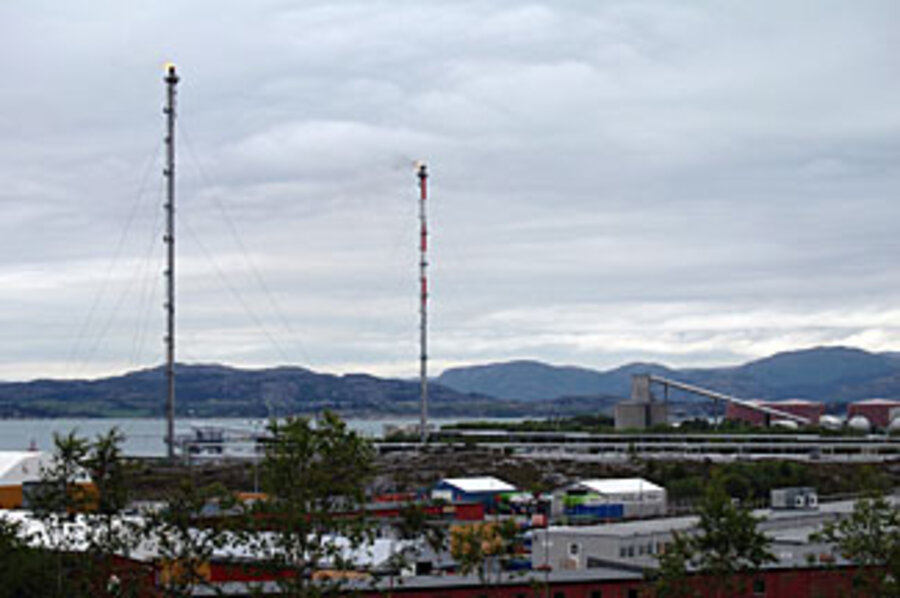The next 'moon landing?' Norway plans deep-sea CO2 storage.
Loading...
| Oslo
Can the North Sea basin hold all of the carbon dioxide in Europe? Norway certainly hopes so.
At a high-level conference in Bergen last month, the oil-rich Nordic nation announced that it will work with Britain to study how the base of the North Sea could be used for carbon dioxide storage for European countries. It will also allocate nearly $200 million toward carbon capture and storage projects in the European Union.
Although some environmentalists aren't yet convinced of the long-term prospects of sequestering carbon dioxide emissions deep under the ocean, the idea has become something of a holy grail in the effort to stop global warming.
The joint British-Norwegian study will build a profile for the whole North Sea, assessing each countries' storage potential and projections of likely volumes and locations of carbon dioxide (CO2) flows. The conference in Bergen, where the plan was announced, took place in advance of December's United Nations Climate Change Conference in Copenhagen.
The North Sea Basin Task Force, which now includes Norway, Britain, Germany, and the Netherlands, has previously estimated the Utsira deep saline formation in the North Sea could store up to 600 billion ton of CO2, equivalent to all the emissions of all the power stations in Europe for the next 600 years.
Utsira is just one of many subsea geological structures being considered as storage sites for carbon emissions. Scotland, for example, announced last month that the Scottish area underneath the Northern and Central North Sea could store emissions from the United Kingdom's coal-fired power plants for the next 200 years, making it comparable to the capacity offshore Norway.
Carbon storage the next 'moon landing?'
Carbon capture is a prestige issue for Norway. It was the first country to store CO2 from an offshore oil platform underneath the seabed, the first to transport and store CO2 subsea from an onshore liquefied natural gas plant, and hopes to be the first to have full scale CO2 capture from a gas-fired power plant.
Prime Minister Jens Stoltenberg has equated the importance of carbon capture and storage technology for Norway to what the "moon landing" was for the United States.
Norwegian oil company Statoil started storing carbon dioxide in the North Sea's Utsira formation underneath the Sleipner oil field platform 13 years ago. Since then, the company has pumped 11 million tons of CO2 into the half-mile thick layer of gas-tight rock. Statoil believes that the 430-mile-long formation has the potential to hold three times as much.
"The reservoir quality underneath Sleipner is very good for CO2 storage and has a potential to hold large amounts," says Øistein Johannessen, Statoil's new energy spokesman. "But Utsira is characterized by sand with different origins and qualities, many with no connection between them. To estimate how large volumes Utsira may store, we need to do more studies of the reservoir."
A major factor leading to Statoil's decision to begin storing CO2 from Sleipner under the seabed was pure economics: It currently costs them around $30 per ton of CO2 to put the emissions underground, roughly the same price as Norway's CO2 tax.
Clean, green Norway?
Norway is the world's third largest exporter of gas and fifth largest oil exporter. Environmentalists have criticized the country for putting more money into carbon capture so that it can continue to pollute rather than investing in more renewable energy.
"The future of the planet is being gambled on a technological solution that could turn out to be an end of the pipe dream," says Emily Rochon, climate and energy campaigner for Greenpeace International. "Governments need to invest in proven solutions like wind, solar, and the smarter use of power."
Greenpeace released a critical report on the Utsira formation during the recent Bergen conference that questioned the safety of storing CO2 underneath the seabed. The group claims most storage estimates are overly optimistic and based on methodologies that are "insufficiently robust."
The report cites the Norwegian Petroleum Directorate, which concluded that it was uncertain whether Utsira was suitable for large-scale storage of Europe's carbon emissions. In addition, the report points to problems last year with a with a crater on the seabed floor leaking oil at the Tordis field, where Statoil was injecting water into the Utsira formation to increase gas recovery.
"It's not possible to prove that all injected CO2 is still there," says Peter Haugan, leader of the Institute of Geophysics at the University of Bergen and an author of the Intergovernmental Panel on Climate Change special report on carbon capture and storage. "There's no way of measuring the amount of CO2with sufficient accuracy using seismic mapping."
Statoil says the Sleipner and Tordis fields are located 200 miles apart and have no connection. Moreover, seismic monitoring from a year ago shows that storage at Sleipner is proceeding as planned.
Full-scale project delayed
Meantime, the country is still grappling with delays at its onshore carbon capture plant at Kårstø, in western Norway. This was supposed to be the site of the world's first full-scale carbon capture at a gas-fired power plant, starting in 2012, with the Utsira formation as a possible subsea storage site.
But the Norwegian government put the brakes on the procurement process last month because the new gas-fired power plant has been operating in fits and starts, producing scant CO2 emissions to date. The Norwegian oil ministry has declined to give a new date for the start-up of the carbon capture plant at Kårstø, though one environmental group believes start-up will be delayed by at least a year.
Meanwhile, the country is proceeding with plans to have a full-scale carbon capture plant for the new gas-fired power plant at Mongstad in western Norway possibly ready by 2014.






